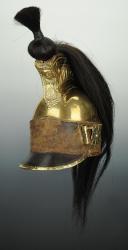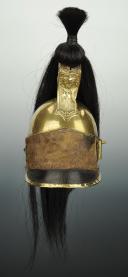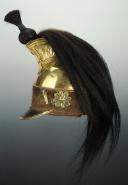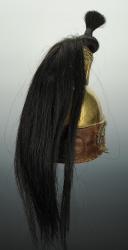
Dragoon helmet, First Empire (around 1803-1810).
Sold out
DRAGOON HELMET, FIRST EMPIRE.
The brass helmet, also known as the dome, is round in shape and measures approximately 100 mm deep. The bottom is equipped with a 5 mm wide flat reeded gutter folded outward to prevent water infiltration under the turban.
The turban consists of a leather band approximately 85 mm high in the front, 74 mm on the sides, and 80 mm at the back. It is covered with a seal skin. At the bottom of the turban at the back, a brass buckle (26 mm in height, 22 mm in width) attached to a leather strap (20 mm in width, 24 mm in length) allows for adjusting and securing the size using a counter strap (17 mm in width, 90 mm in length).
The leather visor is sewn at the bottom to the turban, made of black waxed leather and encircled by a brass reeded band folded over the outer edge (apparent width of 8 mm), measuring 55 mm in length.
The chin straps consist of two parts: the missing soft leather chin strap; the rosette is made of stamped brass in a palmette shape, measuring 60 mm in diameter (a missing rosette later replaced by a reproduction).
The brass plume holder is tubular in shape, 44 mm in height plus the flat part for fixing it at the top, with a screw to secure the plume.
The crest is made of brass with relief-stamped decorations: the wings have a maximum height of 99 mm, each with 9 godrons; the mask is 120 mm high, 46 mm wide; at the top is a representation of a medusa head (50 mm in height, 39 mm in width), and at the bottom, a palmette (32 mm high, 27 mm wide).
The reconstructed plume holder is made of a wooden disc covered with tightly bound black hairs, blossoming at the top into a pompom shape.
The black horsehair mane is of the period.
The interior lining consists of a leather band 512 mm high topped with a 78 mm high fabric band.
Very good condition, with an accident at the top of one wing (likely a sword strike).
First Empire. Dragoon helmets from the First Empire are extremely rare, as they were either used until completely worn out or repurposed as firefighter helmets in small towns. Additionally, a significant number of reproductions were produced in the late 19th and early 20th centuries, notably by Mr. SIRAUDIN.
The helmet I present today is an original piece. The pompom and horsehair are delicate elements often remade, including in major museum collections, however, this does not diminish the historical quality of this extremely rare item.
Frequent reference has been made to the top figure of the crest as either Gorgon or Medusa. While visually there is no distinction between these two monsters—a monstrous face with hair made of snakes—it is important to retain the term Medusa. In Greek mythology, the Gorgons are malevolent monsters of such ugliness that anyone who dares to look directly at them is turned to stone, as mentioned in the texts of that time. The most famous of the Gorgons was Medusa, who unlike her immortal sisters Stheno and Euryale, was mortal.
The brass helmet, also known as the dome, is round in shape and measures approximately 100 mm deep. The bottom is equipped with a 5 mm wide flat reeded gutter folded outward to prevent water infiltration under the turban.
The turban consists of a leather band approximately 85 mm high in the front, 74 mm on the sides, and 80 mm at the back. It is covered with a seal skin. At the bottom of the turban at the back, a brass buckle (26 mm in height, 22 mm in width) attached to a leather strap (20 mm in width, 24 mm in length) allows for adjusting and securing the size using a counter strap (17 mm in width, 90 mm in length).
The leather visor is sewn at the bottom to the turban, made of black waxed leather and encircled by a brass reeded band folded over the outer edge (apparent width of 8 mm), measuring 55 mm in length.
The chin straps consist of two parts: the missing soft leather chin strap; the rosette is made of stamped brass in a palmette shape, measuring 60 mm in diameter (a missing rosette later replaced by a reproduction).
The brass plume holder is tubular in shape, 44 mm in height plus the flat part for fixing it at the top, with a screw to secure the plume.
The crest is made of brass with relief-stamped decorations: the wings have a maximum height of 99 mm, each with 9 godrons; the mask is 120 mm high, 46 mm wide; at the top is a representation of a medusa head (50 mm in height, 39 mm in width), and at the bottom, a palmette (32 mm high, 27 mm wide).
The reconstructed plume holder is made of a wooden disc covered with tightly bound black hairs, blossoming at the top into a pompom shape.
The black horsehair mane is of the period.
The interior lining consists of a leather band 512 mm high topped with a 78 mm high fabric band.
Very good condition, with an accident at the top of one wing (likely a sword strike).
First Empire. Dragoon helmets from the First Empire are extremely rare, as they were either used until completely worn out or repurposed as firefighter helmets in small towns. Additionally, a significant number of reproductions were produced in the late 19th and early 20th centuries, notably by Mr. SIRAUDIN.
The helmet I present today is an original piece. The pompom and horsehair are delicate elements often remade, including in major museum collections, however, this does not diminish the historical quality of this extremely rare item.
Frequent reference has been made to the top figure of the crest as either Gorgon or Medusa. While visually there is no distinction between these two monsters—a monstrous face with hair made of snakes—it is important to retain the term Medusa. In Greek mythology, the Gorgons are malevolent monsters of such ugliness that anyone who dares to look directly at them is turned to stone, as mentioned in the texts of that time. The most famous of the Gorgons was Medusa, who unlike her immortal sisters Stheno and Euryale, was mortal.
Reference :
10877/3264
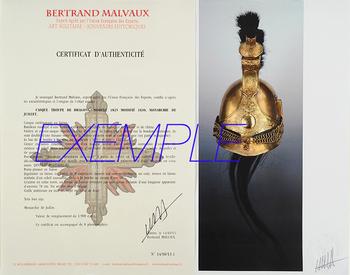
Next update Friday, november 7 at 13:30 PM
FOR ALL PURCHASES, PAYMENT IN MULTIPLE CHECKS POSSIBLE
bertrand.malvaux@wanadoo.fr 06 07 75 74 63
SHIPPING COSTS
Shipping costs are calculated only once per order for one or more items, all shipments are sent via registered mail, as this is the only way to have proof of dispatch and receipt.
For parcels whose value cannot be insured by the Post, shipments are entrusted to DHL or Fedex with real value insured, the service is of high quality but the cost is higher.
RETURN POLICY
Items can be returned within 8 days of receipt. They must be returned by registered mail at the sender's expense, in their original packaging, and in their original condition.
AUTHENTICITY
The selection of items offered on this site allows me to guarantee the authenticity of each piece described here, all items offered are guaranteed to be period and authentic, unless otherwise noted or restricted in the description.
An authenticity certificate of the item including the description published on the site, the period, the sale price, accompanied by one or more color photographs is automatically provided for any item priced over 130 euros. Below this price, each certificate is charged 5 euros.
Only items sold by me are subject to an authenticity certificate, I do not provide any expert reports for items sold by third parties (colleagues or collectors).
FOR ALL PURCHASES, PAYMENT IN MULTIPLE CHECKS POSSIBLE
bertrand.malvaux@wanadoo.fr 06 07 75 74 63
An authenticity certificate of the item including the description published on the site, the period, the sale price, accompanied by one or more color photographs is automatically provided for any item priced over 130 euros. Below this price, each certificate is charged 5 euros.
Only items sold by me are subject to an authenticity certificate, I do not provide any expert reports for items sold by third parties (colleagues or collectors).
